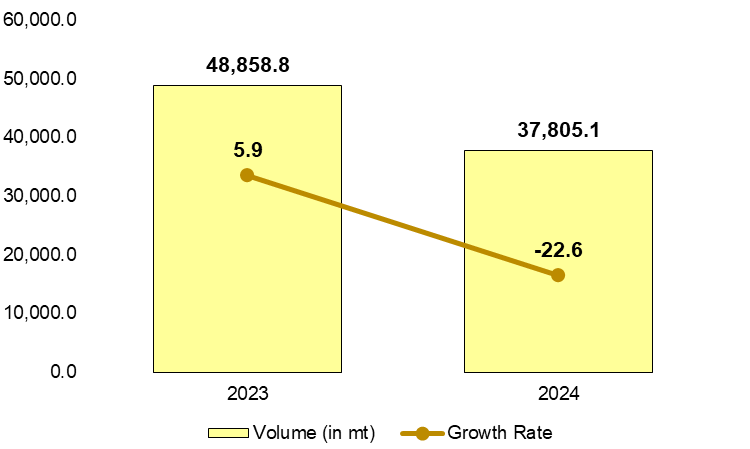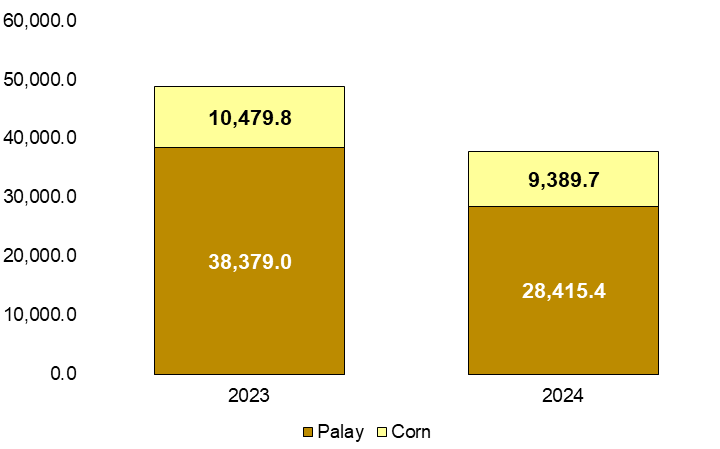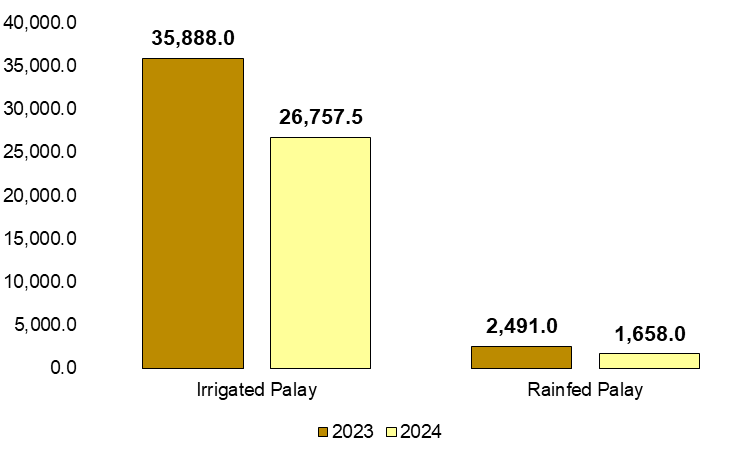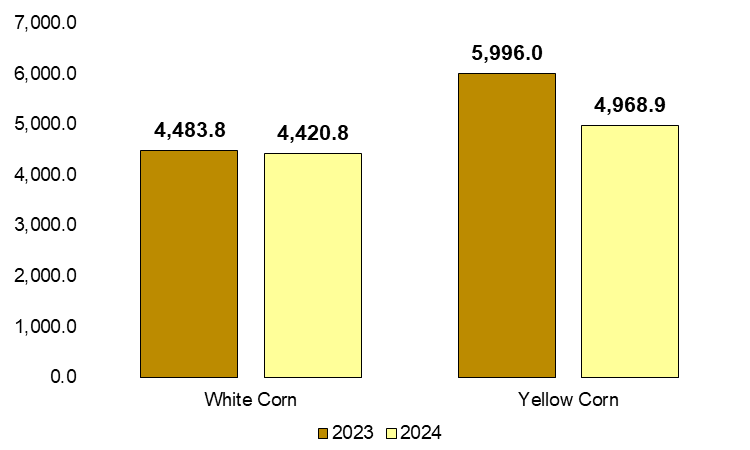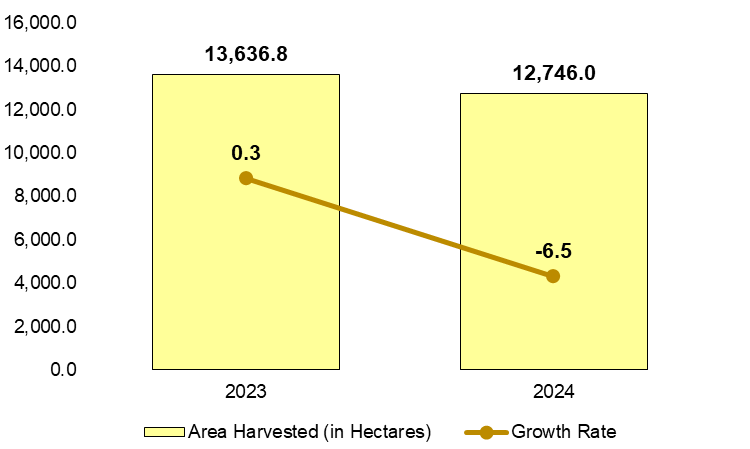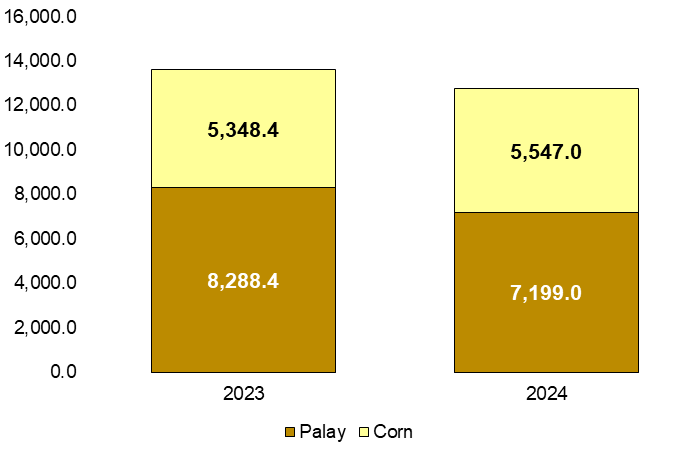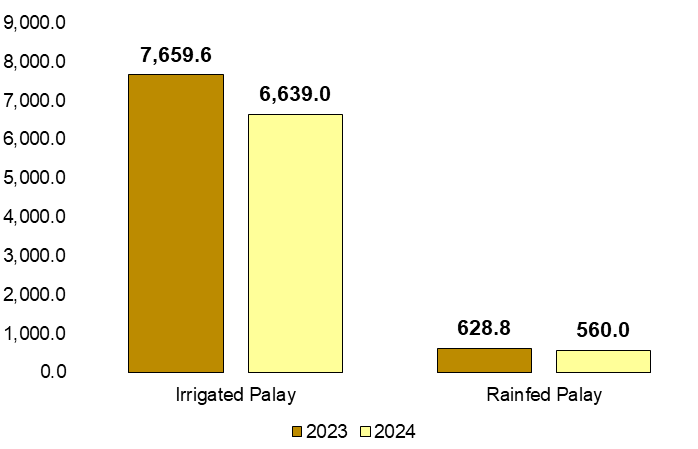Cereal Statistics of Davao del Norte:
First Quarter, 2023 to 2024
Cereal production in Davao del Norte dropped by 22.6 percent in the first quarter of 2024.
In the first quarter of 2024, the overall volume of cereal production in Davao del Norte was 37,805.1 metric tons, a 22.6 percent decrease from 48,858.8 metric tons of the same period in the previous year (Figure 1).
Figure 1. Cereal Production of Davao del Norte |
Source: Philippine Statistic Authority |
As shown in Figure 2, total cereal production in the first quarter of 2023 comprised 38,379.0 metric tons of palay and 10,479.8 metric tons of corn, that is, 78.6 percent and 21.4 percent of the total, respectively. Likewise in the same period of 2024, palay production decreased to 28,415.4 metric tons, or 75.2 percent of the total, while corn production declined to 9,389.7 metric tons, contributing 24.8 percent.
Figure 2. Cereals Production by Crop Type in Davao del Norte |
Source: Philippine Statistic Authority |
In the first quarter of 2024, 26,757.5 metric tons of irrigated palay produced, that is, 25.44 percent decrease from 35,888.0 metric tons in the same period of 2023. Concurrently, rainfed palay decreased by 33.44 percent, from 2,491.00 metric tons in 2023 to 1,657.95 metric tons in 2024 (Figure 3).
Figure 3. Rice Production by Crop Type of Davao del Norte |
Source: Philippine Statistic Authority |
As shown in Figure 4, Davao del Norte produced 4,420.8 metric tons of white corn in the first quarter of 2024, a 1.4 percent decrease from the 4,483.8 metric tons produced in 2023. Similarly, the yellow corn production was at 4,968.9 metric tons in 2024, a 17.1 percent increase from the 3,566.8 metric tons produced in 2023.
Figure 4. Corn Production by Crop Type of Davao del Norte |
Source: Philippine Statistic Authority |
The cereals harvest area in Davao del Norte dropped by 6.5 percent in the first quarter of 2024 (Figure 5), with harvested land decreasing from 13,636.8 hectares in the same period of 2023 to 12,746.0 hectares.
Figure 5. Cereals Harvest Area (in Hectares) in Davao del Norte
|
Source: Philippine Statistic Authority |
Additionally, the harvest area for palay decreased by 13.1 percent, with harvested land dropping from 8,288.4 hectares in 2023 to 7,199.0 hectares in 2024. On the other hand, the harvest area for corn increased by 3.7 percent, from 5,438.4 hectares in 2023 to 5,547.0 hectares in 2024 (Figure 6).
Figure 6. Cereals Harvest Area (in Hectares) |
Source: Philippine Statistic Authority |
In Figure 7, the harvest area for irrigated palay decreased by 13.3 percent, from 7,658.6 hectares in 2023 to 6,639.0 hectares in 2024. Likewise, the harvest area for rainfed palay dropped from 628.8 hectares in 2023 to 560.0 hectares in 2024, indicating a 10.9 decrease.
Figure 7. Rice Harvest Area (in Hectares) by Crop Type in Davao del Norte First Quarter, 2023 to 2024 |
Source: Philippine Statistic Authority |
On the other hand, the harvest area for white corn increased from 3,573.4 hectares in 2023 to 3,756.0 hectares in 2024, indicating a 5.1 percent increase. Similarly, the harvest area for yellow corn also increased by 0.9 percent, from 1,775.0 hectares in 2023 to 1,791.0 hectares in 2024 (Figure 8).
Figure 7. Rice Harvest Area (in Hectares) |
Source: Philippine Statistic Authority |
TECHNICAL NOTES |
The Palay and Corn Production Survey (PCPS) is one of the major agricultural surveys conducted by the Philippine Statistics Authority (PSA). This survey generates estimates on palay and corn production, area, yield, and other production-related data. This data is used as input for policymaking and programs on palay and corn. The PCPS is conducted quarterly.
Production data from the PCPS is used in the Performance of Agriculture Report (PAR) and the preparation of the Gross Domestic Product (GDP). The survey also supports the data needs of planners, policy and decision-makers, and other stakeholders in the agriculture sector. This includes the National Economic and Development Authority (NEDA), Department of Agriculture (DA), and its attached agencies like the Philippine Rice Research Institute (PhilRice), Philippine Council for Agriculture and Fisheries (PCAF), and the general public.
Data collection for the Palay and Corn Production Survey is conducted during the first 10 days of the months of April, July, October, and December.
Harvest Area: The actual area from which harvests were realized. This excludes crop areas that were totally damaged and may be smaller than the area planted.
Irrigated Area: Area with irrigation facilities supplying water through artificial means like gravity, force/power, pump, etc. If the irrigation system has been non-operational for two years or more and there is no plan to repair it, the area becomes rainfed.
Rainfed Area: Palay grown in this ecosystem has dikes that retain water and relies solely on rainfall for its water supply. It can only be converted to irrigation if a permanent irrigation facility is installed.
Crop Production: The quantity produced and harvested for a particular crop during the reference period. This includes harvested crops that were damaged, stolen, given away, consumed, or used as harvester’s and thresher’s shares. It excludes those produced but not harvested due to low prices, lack of demand, force majeure, or fortuitous events.
Metric Ton: A unit equal to 1,000 kilograms.
Approved for posting by:
MICHELLE O. MANINGO
(Supervising Statistical Specialist)
Officer-in-Charge
RKC

